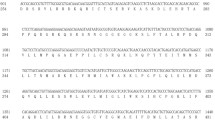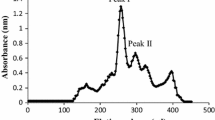Abstract
We present molecular cloning and tissue expression analysis of three estrogen receptor (ER) subtypes, vbERα, vbERβ1 and vbERβ2, from liver of the cyprinid fish Varicorhinus barbatulus through reverse transcription-polymerase chain reaction (RT-PCR) and rapid amplification of cDNA ends (RACE). The sequence alignment and phylogenetic analysis reconfirmed the evolutionary relationship of V. barbatulus within the family Cypriniformes. Directional constraints for subtype-specific substitution of critical amino acids were observed in the E2 binding region. For amino acid substitution, vbERβ exhibited a M517L change in the ligand-dependent transactivation region. The tissue distributions were investigated using RT-PCR with subtype-distinguishable primers. Both vbERα and vbERβ1 were most highly expressed in liver, while vbERβ2 was higher in intestine. Here we demonstrate that the identification and cloning of ER subtypes using PCR is feasible in wildlife in that the temporal and spatial observations are consistent with those from phylogeny analysis and crystal structural investigation by others.





Similar content being viewed by others
Abbreviations
- AF:
-
Activation function
- CK-II:
-
Casein-kinase II
- DBD:
-
DNA binding-domain
- ER:
-
Estrogen receptor
- ERR:
-
Estrogen-related receptor
- LBD:
-
Ligand binding-domain
- MAPK:
-
Mitogen-activated protein kinase
- NCBI:
-
National Center for Biotechnology Information
- PKC:
-
Protein kinase C
- RACE:
-
Rapid amplification of cDNA end
- RT-PCR:
-
Reverse transcription-polymerase chain reaction
- vbER :
-
Estrogen receptor of Varicorhinus barbatulus
References
Ashfield LA, Pottinger TG, Sumpter JP (1998) Exposure of female juvenile rainbow trout to alkylphenolic compounds results in modifications to growth and ovosomatic index. Environ Toxicol Chem 3:679–686
Barkhem T, Carlsson B, Nilsson Y, Enmark E, Gustafsson J, Nilsson S (1998) Differential response of estrogen receptor alpha and estrogen receptor beta to partial estrogen agonists/antagonists. Mol Pharmacol 54:105–112
Bjerselius R, Lundstedt-Enkel K, Olsen H, Mayer I, Dimberg K (2001) Male goldfish reproductive behaviour and physiology are severely affected by exogenous exposure to 17β-estradiol. Aquat Toxicol 53:139–152
Cho H, Katzenellenbogen BS (1993) Synergistic activation of estrogen receptor-mediated transcription by estradiol and protein kinase activators. Mol Endocrinol 7:441–452
Ekena K, Weiss KE, Katzenellenborgen JA, Katzenellenbogen BS (1996) Identification of amino acids in the hormone binding domain of the human estrogen receptor important in estrogen binding. J Biol Chem 271:20053–20059
Enmark E, Gustafsson JA (1999) Oestrogen receptors: an overview. J Intern Med 246:133–138
Filby AL, Tyler CR (2005) Molecular characterization of estrogen receptors 1, 2a, and 2b and their tissue and ontogenic expression profiles in fathead minnow (Pimephales promelas). Biol Reprod 73:648–662
Fu KY, Chen CY, Chang WM (2007) Application of a yeast estrogen screen in non-biomarker species Varicorhinus barbatulus fish with two estrogen receptor subtypes to assess xenoestrogens. Toxicol In Vitro 21:604–612
Gaillard S, Dwyer MA, McDonnell DP (2007) Definition of the molecular basis for estrogen receptor-related receptor-alpha-cofactor interactions. Mol Endocrinol 21:62–76
Garcia-Reyero N, Grau E, Castillo M, Lopez de Alda MJ, Barcelo D, Pina B (2001) Monitoring of endocrine disruptors in surface waters by the yeast recombinant assay. Environ Toxicol Chem 20:1152–1158
Halm S, Martinez-Rodriguez G, Rodriguez L, Prat F, Mylonas CC, Carrillo M, Zanuy S (2004) Cloning, characterisation, and expression of three oestrogen receptors (ERalpha, ERbeta1 and ERbeta2) in the European sea bass, Dicentrarchus labrax. Mol Cell Endocrinol 223:63–75
Härd T, Gustafsson JA (1993) Structure and function of the DNA-binding domain of the glucocorticoid receptor and other members of the nuclear receptor supergene family. Acc Chem Res 26:644–650
Hawkins MB, Thomas P (2004) The unusual binding properties of the third distinct estrogen receptor subtype ERba are accompanied by highly conserved amino acid changes in the ligand binding domain. Endocrinology 145:2968–2977
Hawkins MB, Thornton JW, Crews D, Skipper JK, Dotte A, Thomas P (2000) Identification of a third distinct estrogen receptor and reclassification of estrogen receptors in teleosts. Proc Natl Acad Sci USA 97:10751–10756
Herynk MH, Fuqua SA (2004) Estrogen receptor mutations in human disease. Endocr Rev 25:869–898
Kato S, Endoh H, Masuhiro Y, Kitamoto T, Uchiyama S, Sasaki H, Masushige S, Gotoh Y, Nishida E, Kawashima H, Metzger D, Chambon P (1995) Activation of the estrogen receptor through phosphorylation by mitogen-activated protein kinase. Science 270:1491–1494
Krust A, Green S, Argos P, Kumar V, Walter P, Bornert J-M, Chambon P (1986) The chicken oestrogen receptor sequence: homology with v-erbA and the human oestrogen and glucocorticoid receptors. EMBO J 5: 891–897
Kuiper GG, Carlsson B, Grandien K, Enmark E, Haggblad J, Nilsson S, Gustafsson JA (1997) Comparison of the ligand binding specificity and transcript tissue distribution of estrogen receptors alpha and beta. Endocrinology 138:863–870
Lannigan DA (2003) Estrogen receptor phosphorylation. Steroids 68:1–9
Le Goff P, Montano MM, Schodin DJ, Katzenellenbogen BS (1994) Phosphorylation of the human estrogen receptor. Identification of hormone-regulated sites and examination of their influence on transcriptional activity. J Biol Chem 269:4458–4466
Ma CH, Dong KW, Yu KL (2000) cDNA cloning and expression of a novel estrogen receptor beta-subtype in goldfish (Carassius auratus). Biochim Biophys Acta 1490:145–152
Menuet A, Pellegrini E, Anglade I, Blaise O, Laudet V, Kah O, Pakdel F (2002) Molecular characterization of three estrogen receptor forms in zebrafish: binding characteristics, transactivation properties, and tissue distributions. Biol Reprod 66:1881–1892
Michalik L, Auwerx J, Berger JP, Chatterjee VK, Glass CK, Gonzalez FJ, Grimaldi PA, Kadowaki T, Lazar MA, O'Rahilly S, Palmer CN, Plutzky J, Reddy JK, Spiegelman BM, Staels B, Wahli W (2006) International Union of Pharmacology. LXI. Peroxisome proliferator-activated receptors. Pharmacol Rev 58:726–741
Nagler JJ, Krisfalusi M, Cyr DG (2000) Quantification of rainbow trout (Oncorhynchus mykiss) estrogen receptor-alpha messenger RNA and its expression in the ovary during the reproductive cycle. J Mol Endocrinol 25:243–251
Nilsson S, Makela S, Treuter E, Tujague M, Thomsen J, Andersson G, Enmark E, Pettersson K, Warner M, Gustafsson JA (2001) Mechanisms of estrogen action. Physiol Rev 81:1535–1565
Nuclear Receptors Nomenclature Committee (1999) A unified nomenclature system for the nuclear receptor superfamily. Cell 97:161–163
Ohno S (1999) The one-to-four rule and paralogues of sex-determining genes. Cell Mol Life Sci 55:824–830
Pakdel F, Le Gac F, Le Goff P, Valotaire Y (1990) Full-length sequence and in vitro expression of rainbow trout estrogen receptor cDNA. Mol Cell Endocrinol 71:195–204
Robinson-Rechavi M, Marchand O, Escriva H, Bardet PL, Zelus D, Hughes S, Laudet V (2001) Euteleost fish genomes are characterized by expansion of gene families. Genome Res 11:781–788
Sanyal A, Riggs BL, Spelsberg TC, Khosla S (2005) Bone marrow stromal cells express two distinct splice variants of ER-alpha that are regulated by estrogen. J Cell Biochem 94:88–97
Socorro S, Power DM, Olsson PE, Canario AV (2000) Two estrogen receptors expressed in the teleost fish, Sparus aurata: cDNA cloning, characterization and tissue distribution. J Endocrinol 166:293–306
Sonnenschein C, Soto AM (1998) An updated review of environmental estrogen and androgen mimics and antagonists. J Steroid Biochem Mol Biol 65:143–150
Tremblay GB, Tremblay A, Copeland NG, Gilbert DJ, Jenkins NA, Labrie F, Giguere V (1997) Cloning, chromosomal localization, and functional analysis of the murine estrogen receptor beta. Mol Endocrinol 11:353–365
Yuan SY, Liu C, Liao CS, Chang BV (2002) Occurrence and microbial degradation of phthalate esters in Taiwan river sediments. Chemosphere 49:1295–1299
Acknowledgments
This work was supported by research grant NSC 91-2211-E-009-034 from the National Science Council of Taiwan, ROC, to C.-Y. Chen.
Author information
Authors and Affiliations
Corresponding author
Additional information
Communicated by I.D. Hume.
Rights and permissions
About this article
Cite this article
Fu, KY., Chen, CY., Lin, CT. et al. Molecular cloning and tissue distribution of three estrogen receptors from the cyprinid fish Varicorhinus barbatulus . J Comp Physiol B 178, 189–197 (2008). https://doi.org/10.1007/s00360-007-0210-3
Received:
Revised:
Accepted:
Published:
Issue Date:
DOI: https://doi.org/10.1007/s00360-007-0210-3




